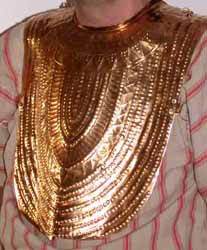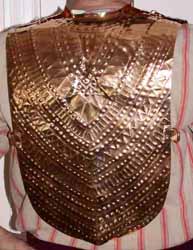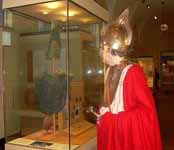|
RECONSTRUCTING THE WARRIORS OF THE
BRONZE AGE
ROMULUS
THE FOUNDER OF ROME --AND THE VILLANOVAN WARRIOR-- 2/10/14 |
To start off with: Terminology. "Villanovan" is the name initially given to culture of the area around Rome and Etruria in the Late Bronze and Early Iron Ages (10th to 7th centuries BC), based on finds made near the town of that name. Now, however, "Villanovan" is apparently being used to describe an *era* and applied to all the varied cultures of Italy, including the Etruscans. Therefore we can still describe the legendary Romulus and Remus (traditionally 753 BC) as Villanovans, but we will leave the semantics of whether that describes their culture or their place in time to the academics! Numerous grave finds give us a good idea of the armaments of the time, though clothing and other perishable items are much harder to document. Connolly's Greece and Rome at War, has been highly inspirational and helpful, and there are two Osprey volumes: Early Roman Armies by Nick Sekunda, and Early Roman Warrior 753-321 BC by Nic Fields.
Clothing is the hardest aspect to research! There is no artwork that is useful--a few bronze figurines show the helmet in perfect detail but are otherwise stick figures... There is LOTS of artwork from a couple centuries later, but how much of it is applicable to the 8th century? Archeological finds are rare and fragmentary. Barber's book Prehistoric Textiles mentions a Villanovan find of linen decorated with weft looping, sort of like terry cloth. But no details about whether that was done in some sort of pattern, etc. So I dragged in evidence from a wider range of time and space to fill the gaps. I hate speculating, but I had to wear SOMEthing!
|
My tunic is striped linen, with a straight rectangular
body and short sleeves. The hem has a blue linen
fringe, and the neckslit is finished in blue linen
thread. I was basically combining a Mycenaean
shape with stripes such as those seen on the later
Vacheres clasp. But since I made this tunic, I'm
wondering if something sleeveless and pinned at the
top might be more accurate, since brooches are such
common grave finds. If I find some spiffy
patterned wool I'll do one that way! Here's a close-up of the fringe, with the border of the cloak showing a sun circle and two of the horses. |
|
| An article in Ancient Warfare by Corrado Re mentions a late Villanovan grave which contained two large woolen mantles or cloaks, crescent-shaped like the toga but smaller. It said they were "mostly dyed in shades of red or orange with fine purple decoration." Nothing else! (Oh, the article also mentioned "what is perhaps some sort of tunic". Grrr....) I really wanted madder red wool, but settled for some nice scarlet red that I already had on hand. How to do the decoration was also a question, until I saw that Plutarch mentions Romulus wearing a toga ("tabenna", the Etruscan word for toga) with a purple *border*. There is also a fresco of an Etruscan wearing a red tabenna or half-circle cloak with a purple border. So I decided on embroidered purple decoration around the edge of my cloak. A couple months of stitching resulted in two bands of zig-zag with 32 little horses and 32 "sun circles" between them (taken from the bronze shield, below). It is nearly 4 yards long by 60 inches wide, somewhat smaller than the toga which forms the backdrop. | |
| Romulus at the University of Pennsylvania Museum's Founding of Rome event, April 21, 2013. This is before the embroidery is done on the cloak. I can wear it like a cloak, pinned at the right shoulder, though if it is simply draped it doesn't cover up my "bling"! | |
|
My experiments with making the common "leech" brooch
from metal did not have enough curvature, so I made
one with a composite body of bone and ebony.
Some of those that survive also use amber. I
learned that it would have been wiser to drill the
holes through each piece *before* gluing them
together, but eventually I got the rotten wire
through, and it works nicely. Surviving leech brooches range from a mere half-inch long to a good 6 inches. Small ones seem to have been simply pinned in pairs down the front of a woman's dress, possibly as closures but maybe just for decoration. The body of a leech brooch was typically hollow cast, and the larger ones bear a striking resemblance to later "arm purses". |
|
|
My other two brooches are spiral types made of bronze
wire, 3-3/8" long and 2-1/4" long. |
|
| Nick Sekunda's Osprey volume, Early Roman Armies, includes a drawing of finds from a grave on the Esquiline Hill in Rome, "Findgroup 98". It includes a 2-part belt hook made of bronze wire. My first experiment was a lightweight version for a purple wool belt, but more recently I used heavier bronze rod to make hooks for a leather belt, just under 3" wide. The tooling was done with humble screwdriver. Being paranoid about the fit, I took a leap and made the belt adjustable by means of a pair of thongs sewn to the back. | |
| Romulus at the Virginia Junior
Classical League convention in Richmond, VA, November
2013. First event with the whole kit more or
less done! I'd like to make a wool tunic, and a
checked cloak would be interesting (possibly as part
of the "Remus" kit!). This is always an amazing event, nearly 2000 very enthusiastic high school Latin students, plus teachers and some parents. The Twentieth Legion is joined by Legiones III and IX, and we give a half-dozen lectures over the weekend on everything from armor to drains. |
|
|
My first attempt at the Villanovan crested helmet,
November 2008. It is made from 18-gauge (c. 1mm)
sheet bronze in two halves, secured by a rectangular
plate with 3 pegs at front and back, and the edge of
one side of the crest folded over the other
side. The progress of its construction can be seen on the
Bronze Age Center, http://z8.invisionfree.com/Bronze_Age_Center/index.php?showtopic=1176
This is a pretty common style, and is frequently called "Etruscan" but I'm not sure they have a claim to its origin. It clearly does derive from the earlier "Kamhelm", and helmets such as the Pass Lueg example from Austria. It came out a little narrow, but it *does* fit on my head! And at the moment it needs a little polishing. The lining is made from linen and wool, glued into place. None of the original helmets of this type seem to have holes punched around the rim for sewing in a lining. |
|
This helmet is copied from on in the Axel Guttmann
collection. It is identified as Villanovan but
there were no other details. I liked it, so I
made it, and I call it my "Remus helmet". It's
actually made from a spun brass dome (leftover from a
Twentieth Legion project from years ago), which I
simply trimmed down a little and added the sheet brass
crest pieces. The crest is horsehair glued into holes in a wooden block. The front of the block has a bronze tab which slides under a strip of bronze riveted to the helmet. At the back a wooden peg goes through a hole in the block and through the last triangular hole in the metal crest piece. The helmet has a wool and linen lining, secured by stitches at the side and at a couple points under the crest block. http://z8.invisionfree.com/Bronze_Age_Center/index.php?showtopic=1268 |
|
 |
Here is the photo of the original--that and the
catalog description were all I had for
information. I may have made my crest block
wider than the original. The shield is 13-5/8
inches in diameter. |
|
Obviously I had to make that shield, too! Total
weight about 2 pounds. http://z8.invisionfree.com/Bronze_Age_Center/index.php?showtopic=1446 |
 |
Helmet by Chris Levatino. He made his first, and it inspired me greatly! His probably fits better than mine, too. https://www.facebook.com/chris.levatino.1 |
 |
Another helmet and shield from the Guttmann Collection. The shield is a little bigger than the one I copied, and is decorated with little horses. Helmets which were intended to serve as lids for cinerary urns (holding the ashes of a cremated person) may not always have been wearable or functional. |
 |
As soon as I saw an illustration of this cuirass in
Peter Connolly's Greece and Rome at War, I
wanted it. It is a unique piece known as a
"poncho cuirass", and the original is in the
University of Pennsylvania Museum in
Philadelphia. So in October 2008 I spent a
couple hours there with camera and notebook, and
hauled out the sheet bronze! Progress photos are
on the Bronze Age Center: http://z8.invisionfree.com/Bronze_Age_Center/index.php?showtopic=1167 I decided to interpret this as a piece of functional armor. The backplate is speculative, since only the breastplate remains. I strongly suspect the original cuirass was a ceremonial or funerary piece, lacking a backplate as well as being too large and thin to serve as functional armor. |
 |
* Main Bronze Age Page * Armor * Weapons * Chronology *
LINKS
Etruscan Warrior Reconstruction, Florida Center for Instructional Technology--http://etc.usf.edu/clippix/picture/etruscan-warrior.html
C
C
BIBLIOGRAPHY
Connolly, Peter. Greece and Rome at War. London: Greenhill Books, first edition 1998. ISBN 185367303X. Reprint edition 2012, ISBN-13 978-1848326095
Fields, Nic. Early Roman Warrior 753-321 BC, Osprey Warrior Series #156. Illustrated by Sean O'Brogain. Oxford: Osprey Publishing, 2011. ISBN 978-1-84908-499-4.
Re, Corrado. "Hero to Hoplite: Villanovan and Etruscan Warriors", Ancient Warfare, vol. IV issue 1, Feb. 2010, pp. 13-17.
Sekunda, Nick, and Northwood, Simon. Early Roman Armies, Osprey Men-at-Arms Series #283. Illustrated by Richard Hook. London: Osprey Publishing, 1995. ISBN 1-85532-513-6.
